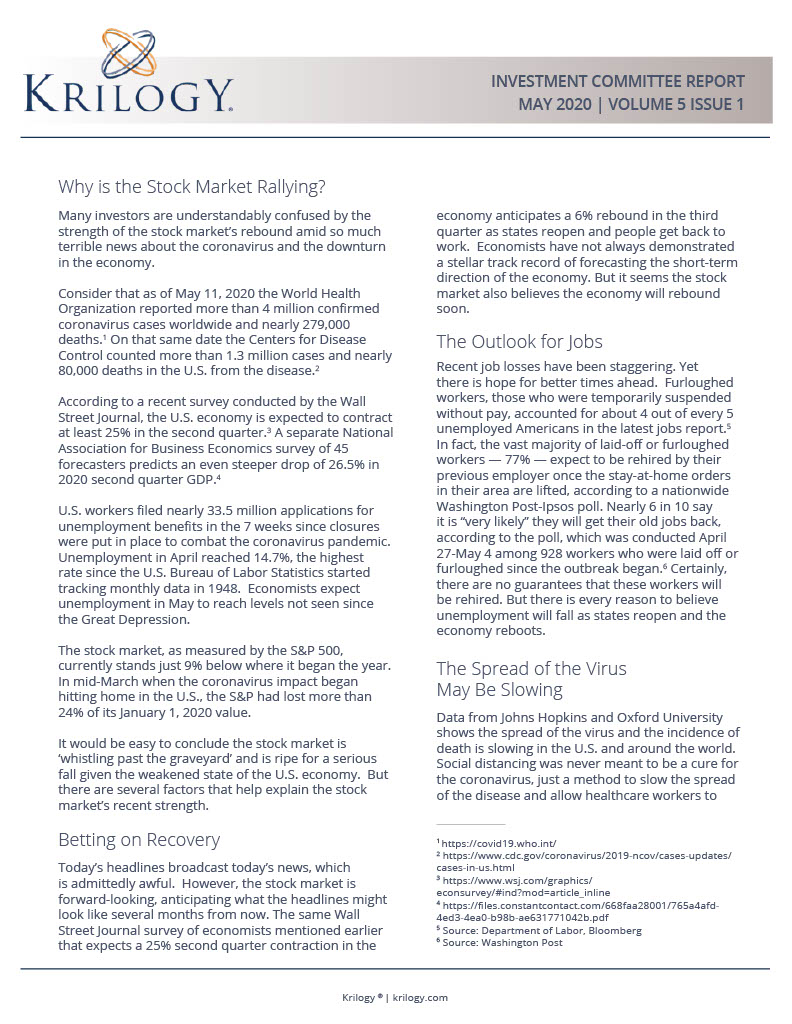Many investors are understandably confused by the strength of the stock market’s rebound amid so much terrible news about the coronavirus and the downturn in the economy.
Consider that as of May 11, 2020 the World Health Organization reported more than 4 million confirmed coronavirus cases worldwide and nearly 279,000 deaths.1 On that same date the Centers for Disease Control counted more than 1.3 million cases and nearly 80,000 deaths in the U.S. from the disease.2
According to a recent survey conducted by the Wall Street Journal, the U.S. economy is expected to contract at least 25% in the second quarter.3 A separate National Association for Business Economics survey of 45 forecasters predicts an even steeper drop of 26.5% in 2020 second quarter GDP.4
U.S. workers filed nearly 33.5 million applications for unemployment benefits in the 7 weeks since closures were put in place to combat the coronavirus pandemic. Unemployment in April reached 14.7%, the highest rate since the U.S. Bureau of Labor Statistics started tracking monthly data in 1948. Economists expect unemployment in May to reach levels not seen since the Great Depression.
The stock market, as measured by the S&P 500, currently stands just 9% below where it began the year. In mid-March when the coronavirus impact began hitting home in the U.S., the S&P had lost more than 24% of its January 1, 2020 value.
It would be easy to conclude the stock market is ‘whistling past the graveyard’ and is ripe for a serious fall given the weakened state of the U.S. economy. But there are several factors that help explain the stock market’s recent strength.
Betting on Recovery
Today’s headlines broadcast today’s news, which is admittedly awful. However, the stock market is forward-looking, anticipating what the headlines might look like several months from now. The same Wall Street Journal survey of economists mentioned earlier that expects a 25% second quarter contraction in the economy anticipates a 6% rebound in the third quarter as states reopen and people get back to work. Economists have not always demonstrated a stellar track record of forecasting the short-term direction of the economy. But it seems the stock market also believes the economy will rebound soon.
The Outlook for Jobs
Recent job losses have been staggering. Yet there is hope for better times ahead. Furloughed workers, those who were temporarily suspended without pay, accounted for about 4 out of every 5 unemployed Americans in the latest jobs report.5 In fact, the vast majority of laid-off or furloughed workers — 77% — expect to be rehired by their previous employer once the stay-at-home orders in their area are lifted, according to a nationwide Washington Post-Ipsos poll. Nearly 6 in 10 say it is “very likely” they will get their old jobs back, according to the poll, which was conducted April 27-May 4 among 928 workers who were laid off or furloughed since the outbreak began.6 Certainly, there are no guarantees that these workers will be rehired. But there is every reason to believe unemployment will fall as states reopen and the economy reboots.
The Spread of the Virus May Be Slowing
Data from Johns Hopkins and Oxford University shows the spread of the virus and the incidence of death is slowing in the U.S. and around the world. Social distancing was never meant to be a cure for the coronavirus, just a method to slow the spread of the disease and allow healthcare workers to avoid being overwhelmed. It seems to have worked. As states reopen for business, it is reasonable to expect the number of cases to rise. The hope is that, if we handle the process thoughtfully, the incidence of infection will be manageable without another nationwide shutdown.

Progress on the Medical Frontlines
Dozens of treatments and vaccines are in various stages of preclinical trials, with several showing promise. Unlike the beginning of the crisis, hospitals have more equipment. Doctors seem to have a better understanding of the disease. Testing has increased dramatically, and test results are available faster. While many challenges remain, there are hopeful signs the health care industry is managing the crisis well. The stock market may be anticipating better days ahead.
Massive Support from the Federal Government
The federal government stepped in quickly to backstop businesses and workers with trillions of dollars. That support includes bank and business loan guarantees ($454 billion), small business payroll protection grants ($377 billion), recovery rebates and direct payments to families ($290 billion), an expansion of unemployment insurance ($220 billion), tax modifications ($229 billion), delayed payment of employer payroll taxes ($211 billion), state and local stimulus funds ($150 billion), supplemental spending, aviation payroll protection ($147 billion) and the Families First Coronavirus Response Act ($134 billion). In addition, the Federal Reserve took additional actions to provide up to $2.3 trillion in loans to support the economy. While the program is far from perfect, these measures have provided necessary support to the economy and much needed liquidity for markets to function properly.
Don’t Bet on the Virus
As irrational as the stock market sometimes seems, it most likely is rising in anticipation of better days ahead. While this crisis is far from over and many challenges remain, we believe investors who stick to a well-thought out investment strategy will be well-rewarded in the long run.
- 1 https://covid19.who.int/
- 2 https://www.cdc.gov/coronavirus/2019-ncov/cases-updates/ cases-in-us.html
- 3 https://www.wsj.com/graphics/ econsurvey/#ind?mod=article_inline
- 4 https://files.constantcontact.com/668faa28001/765a4afd4ed3-4ea0-b98b-ae631771042b.pdf
- 5 Source: Department of Labor, Bloomberg
- 6 Source: Washington Post




















